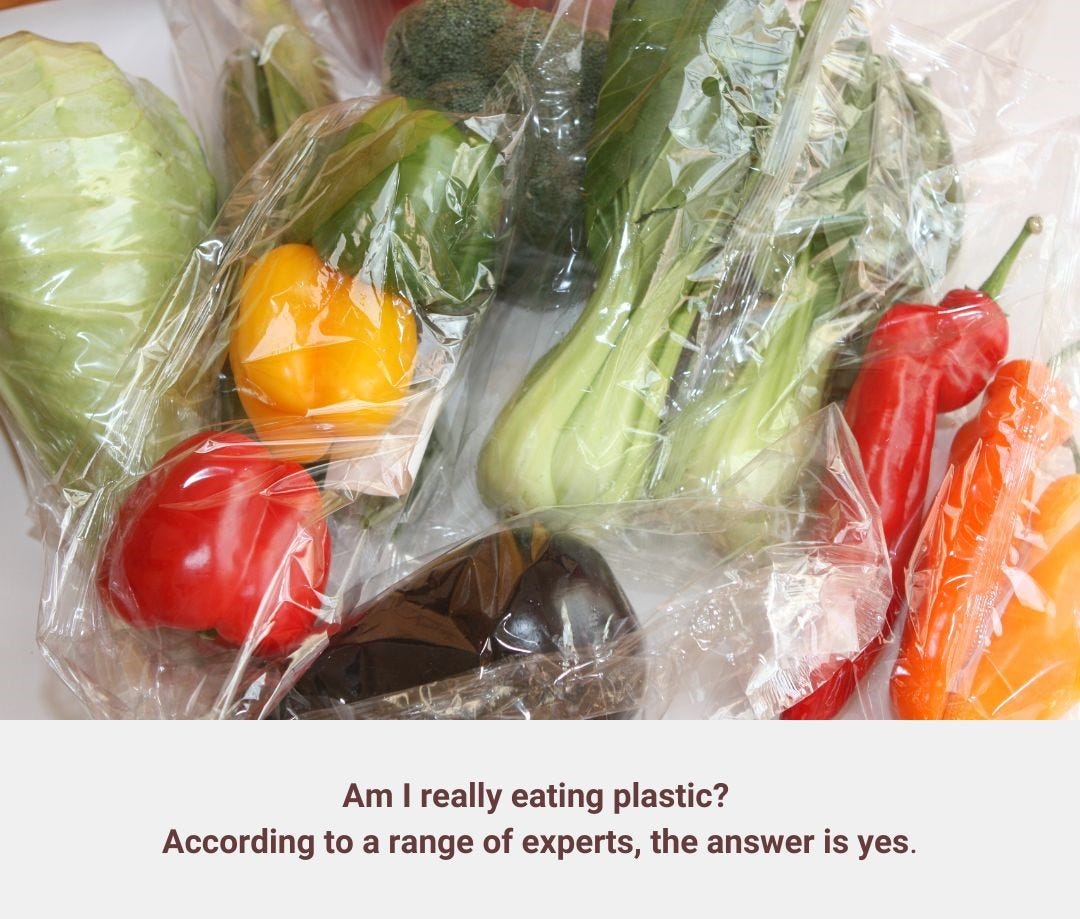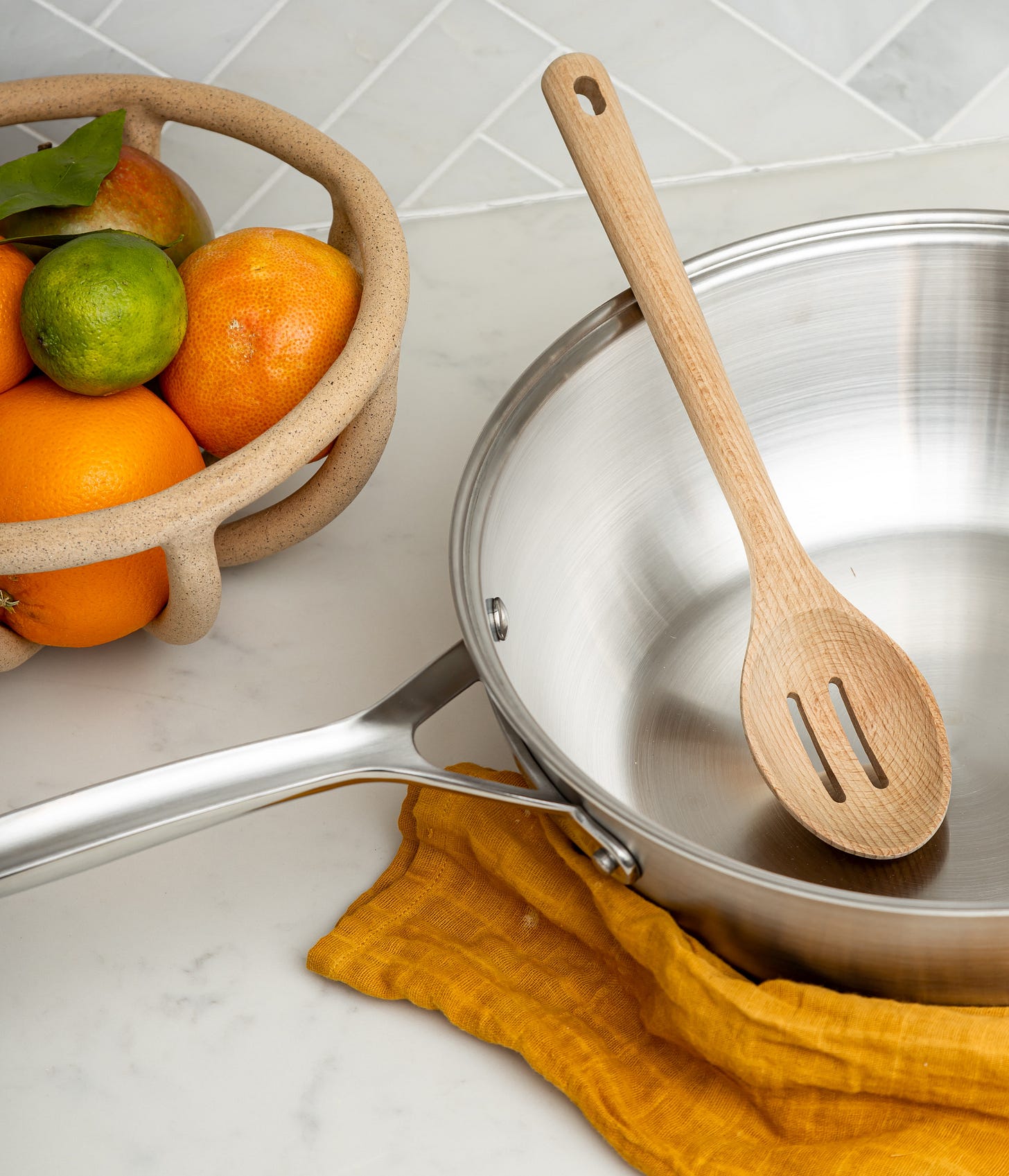Reducing Microplastics in the Kitchen
A look at how my kitchen stacks up + strategies you may want to consider.
Microplastics are having a moment. Despite being studied and discussed by scientists and others for more than a quarter of a century, this topic has truly come to the forefront in the last few years. As you may imagine, it is a multi-layered topic filled with many schools of thought, controversy, and not many clear answers.
After reading a recent article, I was compelled to think more seriously about microplastics in our food and check how my kitchen stacked up. I spent some time researching and this is what I found.
What are microplastics and where do they come from?
Microplastics are just that - tiny pieces of plastic that are released into our environment from degrading plastic items. In homes, they can come from plastic dishware, storage containers, packaging, plastic fibers in fabrics and cleaning tools, dishwasher or laundry detergent pods, microbeads added to facial scrub, and more.
How do they get into our food?
Microplastic researchers tell us that small pieces of plastic get into our food in several ways. They enter the food chain through soil and water from plastic degrading in landfills, bodies of water, and litter on the side of roadways and other areas. Because of this, they become present in the produce and animals we consume. In addition, microplastics can attach to food being prepared in kitchens such as when it is heated in plastic containers, cut on plastic cutting boards, or wrapped and stored in a variety of plastic materials.
What harm do microplastics cause?
This is a tricky part. While scientific evidence shows many chronic medical conditions and diseases are caused by various pollutants, the level and type of harm caused by microplastics is unclear. I came across varied points of view among researchers, scientists, and medical professionals, and the consensus seems to be that much more research needs to take place to answer this question solidly.
On a very basic level, we know that reducing the amount of plastic put out into the world benefits the environment, and in turn, animals and humans.
Five strategies for reducing microplastics in our kitchens.
Look around your home. Plastic is everywhere in our lives and we are very accustomed to having it. It would be difficult, if not impossible to eliminate all contact with plastic and the resulting microplastics. It’s also easy to go down a rabbit hole and feel overwhelmed trying to do so.
However, I have learned that lessening the amount of microplastics in our homes is doable, and I believe a good place to start is in the kitchen. A few common threads in my research were these five points.
Heat causes plastic to break down and shed. Do not:
heat foods in, on, or covered in plastic (even if labeled “microwave safe”)
place hot foods into plastic storage containers
wash plastics in the dishwasher
Choose glass or silicone for use with food whenever possible. If plastic is used, food-grade containers free of BPA and phthalates are considered safer choices. In addition, it is important to consider the item’s intended use. For example, a plastic container intended for dry food storage should not be used for hot or wet foods.
Use wood cutting boards rather than plastic ones to prep food. Wood or silicone utensils are also recommended.
Lessen the use of plastic wrap and storage bags by using reusable wax wrap, non-coated parchment paper, or foil instead.
Choose fresh rather than highly processed foods, as much as possible. When tested, highly processed foods are shown to contain higher levels of microplastics. Fresh foods have less exposure to plastic during the food production process.
How does my kitchen stack up?
This exercise made me evaluate my materials, routines, and conveniences, and I was happy to learn that I was headed in a positive direction for reducing microplastics in my kitchen.
I use:
wood cutting boards and wooden or silicone utensils most often
fresh, less processed ingredients rather than highly processed ingredients
some glass storage containers like mason jars and other options
an under-sink NSF-certified water filter. (A filtered water pitcher would also work.)
stainless steel and cast iron cookware rather than coated non-stick pans
glass, ceramic, porcelain, and stainless steel prep bowls and serveware
reusable shopping bags and baskets, water bottles, and drinking straws
cloth produce storage bags or tea towels for storing produce
a tea ball for brewing loose-leaf tea rather than a tea bag
I could do more by:
eliminating my two plastic cutting boards
swapping out my current plastic food storage containers for glass
lessening the use of cling wrap and zip-lock plastic bags by wrapping food in foil, bee’s wax wrap, waxed paper, or non-coated parchment paper more often
not covering food with plastic bowls when heating in the microwave
washing plastics by hand rather than in the dishwasher
choosing items without plastic packaging whenever possible
returning to powdered dishwasher detergent in place of pods
swapping out tea bags for loose-leaf tea
using a glass carafe or bottle for the SodaStream instead of a plastic one
Start small, and build from there…
Some strategies for reducing microplastics are simple to implement, while others require time, effort, and money. Thoughts on what is necessary and achievable will vary from person to person. For example, replacing ALL of my plastic storage containers (for leftovers and dry and cold pantry goods) with glass containers would be terrific, yet very costly and a great effort if done all at once.
Based on current information, my approach will focus on the heat sensitivity issue. I have ordered a few new glass food storage containers for leftovers to see what works well, will avoid washing plastic in the dishwasher, and avoid using any plastic (even if labeled “microwave safe”) to cover food in the microwave. I will add a smaller wood cutting board to my collection to replace the two plastic ones and be more mindful of reaching for non-plastic wraps whenever possible.
Resources
If you wish to dive deeper into this topic, check out these resources.
Leicht, Laurel. (2024, February 5). Simple Kitchen Swaps to Reduce Your Exposure to Microplastics. Health Central
https://www.healthcentral.com/chronic-health/simple-kitchen-swaps-to-reduce-your-exposure-to-microplasticsLoria, Kevin. (2020, April 30). How to Eat Less Plastic. Consumer Reports. https://www.consumerreports.org/health/health-wellness/how-to-eat-less-plastic-microplastics-in-food-water-a8899165110/
Okamoto, Katie. (2024, June 10). Microplastics Are Everywhere. Here’s How to Avoid Eating Them. New York Times Wirecutter. https://www.nytimes.com/wirecutter/reviews/how-to-avoid-eating-microplastics/
Pinto-Rodrigues, Anne. (2023, March 24). Microplastics are in our bodies. Here’s why we don’t know the health risks. ScienceNews. https://www.sciencenews.org/article/microplastics-human-bodies-health-risks
Sloat, Sarah. (2024, June 7). How to Minimize Your Exposure to Microplastics. New York Times. https://www.nytimes.com/2024/06/07/well/microplastics-health.html
Zachos, Elaina. (2023, August 17). Microplastics are hidden in your home. Here’s how to avoid them. National Geographic. https://www.nationalgeographic.com/environment/article/how-to-avoid-microplastic-health-home
YOUR TURN…
Are you concerned about microplastics in your home?
What are you doing in your kitchen to reduce the amount of microplastics?
Share with us in the comments section.








I’ve discovered a lot of plastic in my coffee-making but have found interesting and inexpensive glass alternatives. There are the Bodum French Press, the Hario v60 pour-over or Switch Immersion in glass, and the Yama and Bodum vacuum pots. And all the systems make full flavor great coffee!
What a really interesting and helpful article.